It was just like it looked in the brochure - beautiful mountains, blue sky, good food and superb organisation. We decided to take the whole family, with all ages being able to enjoy the good, clean, outdoor fun. For those used to wet walks in the Peak District, this really was the Promised Land.
I’d been to Corvara before. It sits in a heartbreakingly lovely location at the heart of the Dolomites, surrounded by the pointiest peaks you could wish for. When I was there at New Year, trying to keep my skis straight and my nuts warm, the place was buried in feet of snow. It was breathtakingly pretty, but also breathtakingly cold – literally. I remember being able to maintain the same skiing position all morning, after getting out of the cable car and freezing solid. Hard to believe then that this same place was now green, friendly, warm and welcoming. The sun belted down on us all week long, as if it had had enough of the Costa del Sol and was pleased to be somewhere a bit more interesting. Scorchio. |
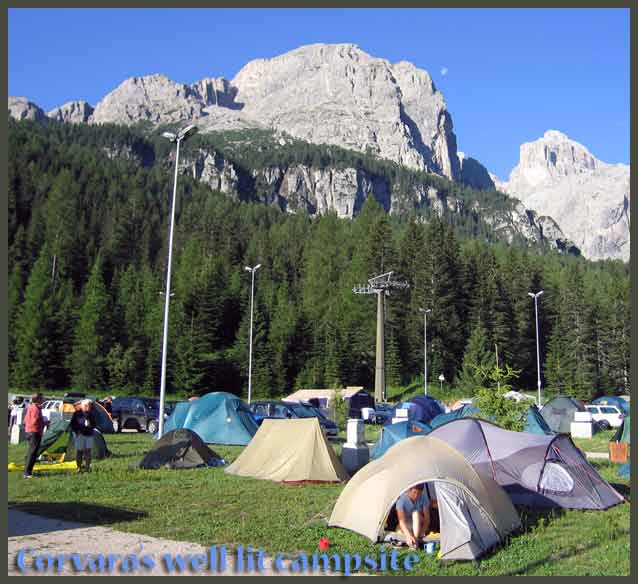 |
The other thing that makes this part of the world so special is the via ferrata. These are aided and graded mountain routes that vary from easy to queasy. Just follow the wire and you’ll get higher. You don’t have to be all that able, so long as you can hold onto a cable. I mean, my climbing is about as good as my rhyming. Choss.
After making the schoolboy error of flying Air France, Paul and I eventually caught up with Rupert and Catherine, piled into a Fiat that was far too big to be a Fiat, and headed for the hills. Everybody had gone to bed by the time we finally made it to the campsite, which made it a bit tricky to find them. We guessed right, and woke everybody up just to be sure.
The next day dawned bright and early, as indeed did all the other days. We met our companions for the week and decided we’d like our own company for today, thank you very much. So the 4 of us jumped in the car and drove as far as the road went, which was about 1 mile on this particular Sunday. The locals had shut the mountain passes to motor vehicles, allowing 100’s of cyclists to drown in their own lead-free sweat. I was most impressed, though not impressed enough to join in, and went up in the bubble-lift with the others. Once at the top, we did a couple of short via ferrata on the nursery slopes and congratulated ourselves on our choice of holiday. All of us had slogged up enough Scottish mountains in the rain and mist to be embarrassed by how easy it was to reach such fantastic surroundings. Furthermore, those nice Italians had managed to put a hut in most of the places where you might be getting a bit thirsty. After establishing that the others had also had a predictably nice day, we watched them begin to prepare a suitably fine dinner. Anybody who has been anywhere with Martin and Sue will know what I mean. We discussed our own options and quickly decided on a restaurant. Al fresco may have been invented in Italy, but then so was pizza. When in Rome … As it turned out, we didn’t put the stove on all week. My kind of holiday. A rather bigger party headed off next morning for Piz Boe, the highest peak in the Sella Gruppe, a shapely and spiky set of summits above Corvara. Think of the Skye Cuillin with knobs on. This time the via ferrata was a bit more serious, providing lots of interest for those who’d done plenty before, as well as those who claimed they were just walkers really. My respect to you all, for remaining calm and good company at all times. |
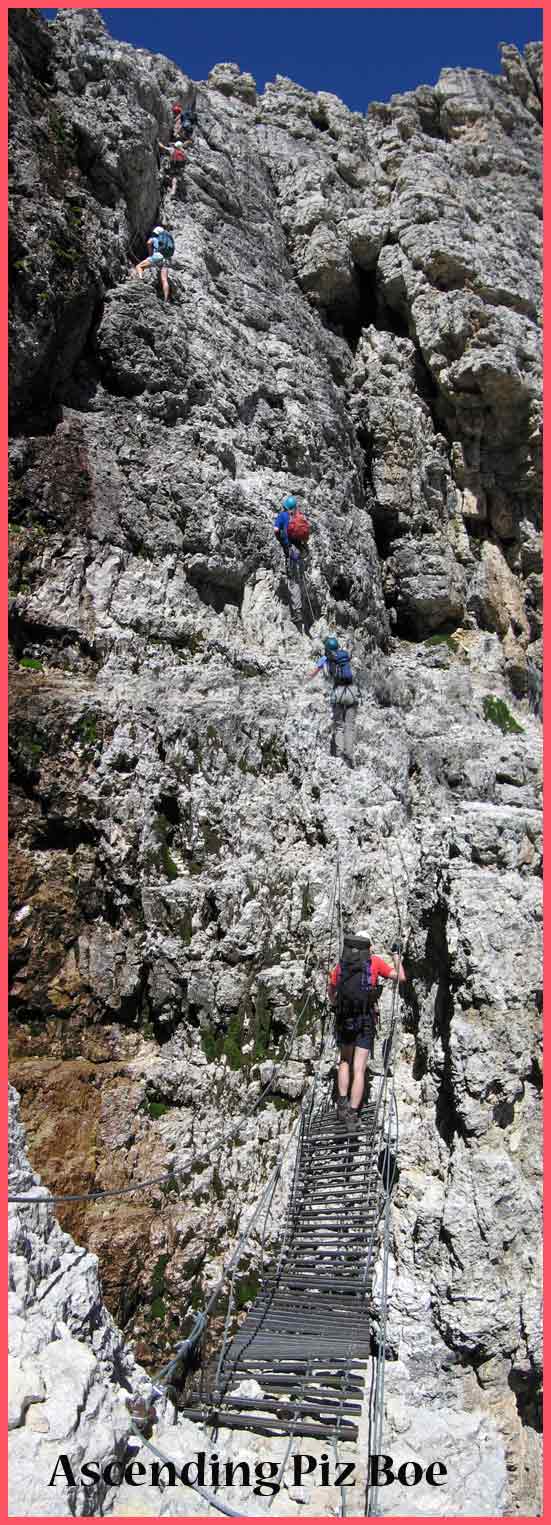 |
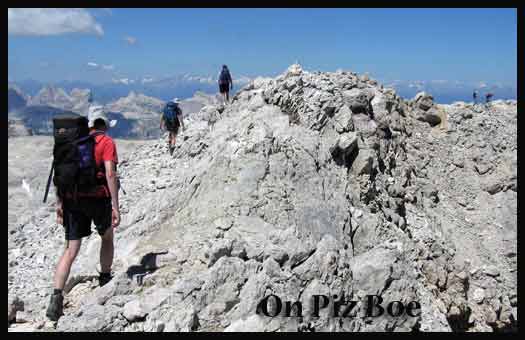 |
There then followed a long walk and some light scrambling before we finally made it to the top. Luckily, the summit was broad enough for us to sit down and have our lunch on. Unluckily, it was also broad enough for 300 Italian schoolchildren – and a bloke with a megaphone who may or may not have been their leader. Unbelievable view. Unbelievable noise. |
Up next was the popular Tridentina route (see below for a more detailed report on this day), demanding an early start. On this evidence, 3am would be about right. Tridentina is rightly regarded as a classic, choosing a spectacular line up and across a rocky face, with a waterfall and bottomless gorge thrown in for good measure. Sure, so there's plenty of metal to hang onto, but the situation makes you tend to forget about that. Lots of air - that's what I remember. Looking at it from across the valley, you would never believe that anyone would be daft enough to place a route there at all.
We were soon stuck in a long queue of helmeted and harnessed holidaymakers, all edging slowly up the blessed cable. As usual, I had positioned myself at the rear of our group, partly cos rears tend to be more appealing than sweaty faces, but mainly cos it allowed me to get away with dodgy technique in private. Unfortunately, this tactic was now exposed by a large German who offered free climbing advice and bottom-fondling. I'd recommend Tridentina to anyone, so long as you don't mind lots of hanging around with little below your feet.
Rupert and I then felt sufficiently sick of other people to go off on what we thought was a quite difficult VF above the Passo Sella. No crowds this time, but we did have two 9-year old girls ahead of us, who clearly didn’t spend enough time at home watching Pop Idol. I was happy to let Rupert go first and demonstrate his climbing age to be about 7, which is actually quite respectable given his childhood.
I think this one was called Mesules, and went up a steep face with lots of interesting situations along the way. All of the exposed stuff was wonderfully protected, thus allowing us to enjoy each tricky move, or cheat as the mood took us. We paused at one point to watch the young girls make light work of a chimney section, then haul ourselves up it with much less style. This may be why we used to send children up chimneys – they’re better at it.
Next day, we had a long walk-in from the Passo Pordoi, only to find that when we got to the start of our VF, there was a queue that would have done airport security proud. Furthermore, this queue didn’t seem to be moving (perhaps they discovered someone with suspicious hand luggage?), so we decided to nip round the back of the first steep section and take it from there. Once again, the rock was solid and stunning, with metal bits in all the right places.
I learnt that it is hard to go to the toilet halfway along a VF with a harness on, and Jenny learnt that Italian gravity is much the same as British gravity. Her ancient helmet fell from a great height, which I’m sure is what it would have wanted. Gary very decently passed his over and went native. He was last seen scooting round Milan on the back of a Vespa.
That night, the others lowered their culinary standards to come out for dinner with us, on account of it being Judith’s birthday. This also seemed to be a fitting way to mark the end of our group holiday, as some of us left next morning in an attempt to expand our cultural horizons. Of course, I realise I could do that by going to Blackpool, but felt that Venice might be a bit more up my canal.

Anyway, we still had time for a leisurely walk next day, which was as clear and hot as all the other ones. Catherine and I went up a delightfully crumbly little mountain called Averau (the one in the foreground of the above panorama), and got stuck below some Italian muppets making a complete Bolognese of the cabled section. They had no gear, and no idea. One rucksack and two brain cells between them.
You will know that Venice is rather flat and therefore not worth speaking of. The Dolomites on the other hand – now that is a place I could go on my holidays every year. Just make sure you book with Banfields though.
Dave Sorensen
© David Sorensen - 2006
This article was originally written for ‘Chunks’, the Newsletter of the International Munro Pineapple Society,
and is reproduced here with kind permission of the editor
Top
Via Ferrata Brigata Tridentina
There’s a sure-fire way to enhance the excitement of travelling to, and arriving at, a new location, and that’s to do so in the dark. If that location is mountainous, so much the better. The switchback roads seem steeper and more tortuous, and you just know that somewhere out there in the blackness, great peaks are rising directly above the road to uncertain heights. Of course, the denouement comes with exiting the tent the following morning. Where previously the extent of the surroundings was limited to the surrounding tents and the toilet block (and perhaps some mysterious lights in the sky marking impossibly positioned alpine huts), the world now expands to show that your tent is hemmed in by soaring spires of rock, with a ceiling of clear blue sky. At least, that was the case if you were camped at “Camping Colfosco” in the heart of the Italian Dolomites, on Sunday 16th July this year.
One of those soaring spires marks the culmination of the Via Ferrata Brigata Tridentina, though I didn’t know it at the time. Everything surrounding the campsite looked utterly impossible to someone always happier to bimble along Derwent Edge whilst ignoring the gratuitous gymnastics of ones companions on the various pineapples sprinkled along the route.
Later on during that first day, having completed a couple of relatively easy Via Ferrate, Rupert gesticulated towards the opposite side of the valley (the Sella Massif), trying to locate a mid-grade Via Ferrata route – the Tridentina – that he’d completed a few years previously. I assumed that Rupert was mistaken – surely anything up this near-vertical wall wasn’t going to be mid-grade – and returned to photographing a stunning Alpine Lily that was growing near the path.
The next day found a group of us in a local restaurant – attacking pizzas the size of dustbin lids – tired and happy after a day climbing Piz Boe, the highest peak in the Sella Massif. The main Via Ferrata of the day had seemed quite hard to me, but was still only a Grade 2 (the grades running from 1 at the easiest to 5 at the hardest). The talk then turned to what we were going to do next and quickly settled on the “Tridentina”. This venerable route has been around for many decades, and is a very popular trip from Corvara. With 2000 feet of ascent, almost all of it protected Via Ferrata climbing, this was a chance to get into situations otherwise reserved for competent climbers. As I have not the slightest intention of ever becoming a competent climber myself [not with hundreds of lifetimes’ worth of long-distance trekking routes and coastline left to explore] this was an opportunity too good to miss.
The only real downside to this high-quality route is that, given the wall-to-wall sunshine we were experiencing along with the route’s easy access, the rest of the world wanted to climb it too. This problem is ameliorated by getting up at the crack of dawn, and thus getting a head-start on the swarms of Germans, Austrians, Italians, French – oh yes, and Brits too – that have put an ascent of the Tridentina on the day’s itinerary. We didn’t do too badly getting up and away early, but on arrival at the car park, a throng of would-be climbers could be seen staggering around with half-tied harnesses and tripping over their Via Ferrata kits. This was clearly no time for a faff, and amazingly, I managed to get my harness on correctly first time.
The first section of the route is less than ten minutes’ walk from the car park, and was to be my introduction to “stempels”. Within our group, opinion seemed to be divided as to the merits of these staple-like hoops of iron, hammered into the rock like ladder-rungs at convenient intervals – I thought they were great, and everybody else hated them. This was no doubt a reflection of my own Via Ferrata philosophy, easily summarised thus: “If there’s a convenient cable or hulking great lump of iron within reach, grab it and hang on for dear life”. I liked stempels... The stempel stairway led easily up a smooth slab and onto less steep ground, and then the route headed into a wet corner for the final part of this first section. This was the only part of the route with a noticeable amount of loose rock – overall the quality of the rock is top-class. A ten-minute stroll along a contouring path takes one to the start of the second and longest section. Although it was busy, I found this main section of the route a joy – climbing sun-warmed rock in relative safety, and with some sections that were remarkably exposed, this is exactly what I’d hoped Via Ferrata would be like. |
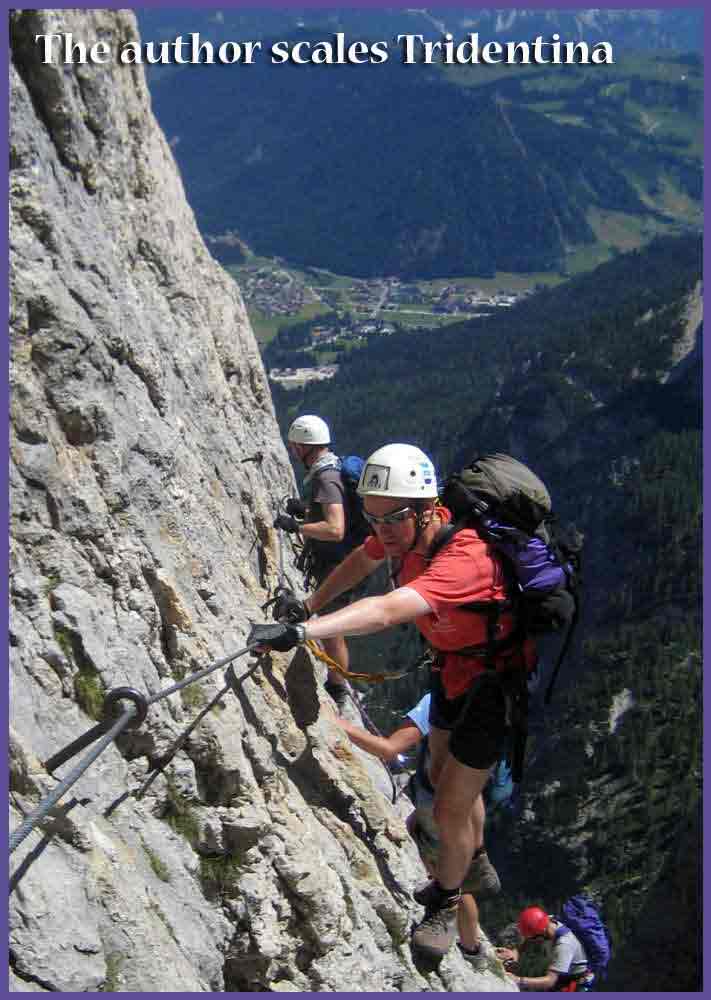 |
The final section (reached just above a possible escape route) was easily the hardest, with the rock steepening noticeably compared to the lower sections of the route. There were plenty of bits of iron around to help though – pegs, stempels (Mmm..., stempels), and even an iron ladder. All of which led to the famed bridge at the very top of the route – quite a solid affair, but fantastically positioned above a seemingly bottomless gorge.
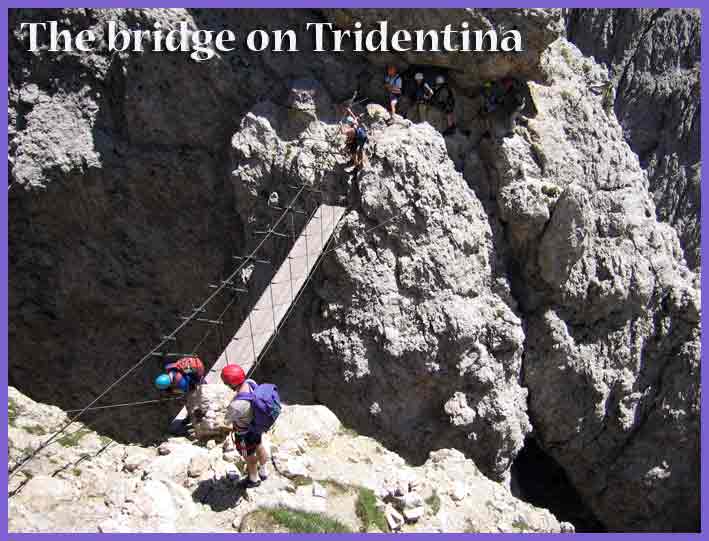 |
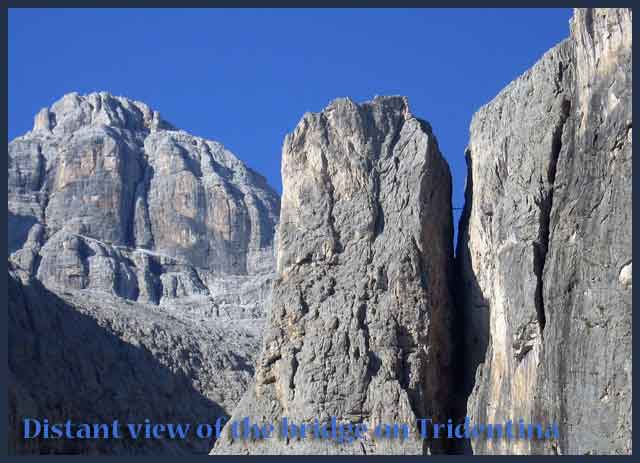 |
By the end, I was feeling pretty knackered. I suspect my “grab hold of anything made of iron and heave up on it” approach wasn’t the most efficient. Lunch overlooking the bridge was followed by a round of drinks and apple strudel at a conveniently located hut – an appropriate reward for our efforts, and good preparation for the descent. There was some much easier Via Ferrata on the way down, and then for some, a reverse of the first part of the Tridentina route! I was all Ferrata’d out by this stage in the proceedings, and was quite content to scamper down the massive scree fan that led back to the car park, rather than put my Ferrata kit back on.
I can’t recommend this route highly enough to anyone reasonably agile who doesn’t suffer from vertigo. It was certainly the highlight of the week for me, and, despite discovering the existence of a fantastic long-distance path nearby (the Alta Via 2) – I think I could quite easily be tempted into digging out my Via Ferrata kit again sometime!
Paul
© Paul Filby - 2006
This article was originally written by Paul Filby for ‘Chunks’, the Newsletter of the International Munro Pineapple Society,
and is reproduced here with kind permission of the editor